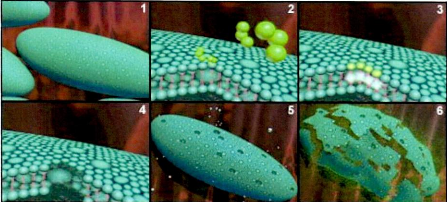Effect of Ozone on Bacteria

- Computer generated image of a bacteria cell
- Close-up of ozone molecule coming into contact with bacteria wall
- Ozone penetrating and creating hole in bacterial wall
- Close-up effect of ozone on cell wall
- Bacterial cell after a few ozone molecules come into contact
- Destruction of cell after ozone (cell lysing)
As a comparison based on 99.99% of bacterial concentration being killed and time take: Ozone is
- 25 times more effective than HOCI (Hypochlorous Acid)
- 2,500 times more effective than OCI (Hypochlorite)
- 5,000 times more effective than NH2CI
Further more, ozone is at least 10 times stronger and more effective than chlorine as a disinfectant. Chlorine reacts with meat forming highly toxic and carcinogen compounds called THMs (tri-halomethanes) rendering meats lesser quality products. THMs were also implicated as carcinogens in developing kidney, bladder, and colon cancers. Chlorine also results in the production of chloroform, carbon tetrachloride, chloromethane besides THMs. As opposed to this, ozone does not even leave any trace of residual product upon its oxidative reaction.




